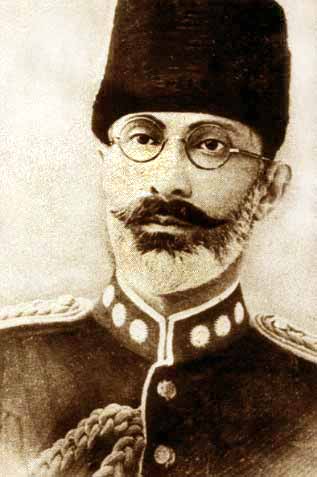<Back to Index>
- Mathematician Élie Joseph Cartan, 1869
- Composer Paolo Tosti, 1846
- King of Afghanistan Mohammed Nadir Shah, 1883
PAGE SPONSOR


Mohammed Nadir Shah (Pashto: محمد نادر شاه - born Mohammed Nadir; April 9, 1883 - November 8, 1933), was king of the Kingdom of Afghanistan from October 15, 1929 until his assassination in 1933. He and his son Mohammed Zahir Shah, who succeeded him, are sometimes referred to as the Musahiban.
Mohammed Nadir Khan was born in Dehra Dun in British India into Mohammadzai section of Barakzai tribe, on April 9, 1883 to Muhammad Yusuf Khan and his first wife Sharaf Sultana. His paternal grandfather was Yahya Khan and his great grandfather was Sultan Muhammad Khan Telai, the brother of Dost Mohammed Khan, who accepted the Sikh dominance in Peshawar. Thus he was a member of the Musahiban branch of the family.
Mohammed Nadir first set foot in Afghanistan at the age of 18 when his grandfather Mohammed Yahya was authorized to return to Afghanistan from exile by the British and Abdur Rahman Khan.
Nadir Khan became a general under Amanullah Khan. He led Afghan forces in the Third Anglo - Afghan War. After the war, Nadir was made Minister of War and Afghan ambassador to France.
Shortly after a rebellion by Pashtun tribesmen and forces of Habibullah Kalakani began
against the monarchy, Mohammad Nadir was exiled due to disagreements
with King Amanullah. After the overthrow of Amanullah Khan's monarchy
by Habibullah Kalakani, Mohammed Nadir returned to India and acquired
military support from the British. He returned to Afghanistan with his
British supported armies and took most of Afghanistan from Habibullah
Kalakani. By October 13 of 1929, Mohammad Nadir Khan captured Kabul and subsequently sacked the city. Nadir
Shah then asked for a truce with Habibullah Kalakani and asked him to
join him so that they could discuss the political upheavals and come to
a resolution. Kalakani accepted Mohammed Nadir's truce and went to Nadir's meeting accompanied by Nadir's religious envoy. Upon his arrival Habibullah Kalakani was shot and hanged (17 October). Mohammad Nadir Khan already declared himself King, or Shah, of Afghanistan on 16 October 1929. Mohammed Nadir Shah quickly abolished most of Amanullah Khan's
reforms, but despite his efforts to rebuild an army that had just been
engaged in suppressing a rebellion, the forces remained weak while the religious and tribal leaders grew strong. In 1930, there were uprisings by the Pashtun Shinwari tribes of the south and as well as by Tajiks of Kabul province and north of Kabul. The same year, a Soviet force crossed the border in pursuit of an Uzbek leader
whose forces had been harassing the Soviets from his sanctuary in
Afghanistan. He was driven back to the Soviet side by the Afghan army
in April 1930, and by the end of 1931 most uprisings had been subdued. Nadir
Shah named a ten member cabinet, consisting mostly of members of his
family, and in September 1930 he called into session a loya jirga of
286 which confirmed his accession to the throne. In 1931 the King
promulgated a new constitution. Despite its appearance as a
constitutional monarchy, the document officially instituted a Royal
oligarchy, and popular participation was merely an illusion. Although
Nadir Shah placated religious factions with a constitutional emphasis
on orthodox denominational principles, he also took steps to modernize
Afghanistan in material ways, although far less obtrusively than
Amanullah. He improved road construction, especially the Great North
Road through the Hindu Kush, methods of communication, and helped establish Afghanistan's first university in 1931; however, this university (Kabul University) didn't admit any students until 1932. He
forged commercial links with the same foreign powers that Amanullah had
established diplomatic relations with in the 1920s, and, under the
leadership of several prominent entrepreneurs, he initiated a banking
system and long range economic planning. Although his efforts to
improve the army did not bear fruit immediately, by the time of his
death in 1933 Nadir Shah had created a 40,000 strong force from almost
no national army at all. He
waged a large scale campaign under British influence against the
non Pashtun ethnic living in Afghanistan in attempt to continue the
Pashtunization plan of his predecessor Abdur Rahman Khan. During his
reign thousands of Afghan intellectuals were either imprisoned or
killed. Many fled abroad, especially to the Soviet Union. The
already - in - crisis press was heavily censored and power was distributed
among his own relatives and family members. During
his reign, Nadir Shah had to suppress attempts to reinstate Amanullah
Khan to the throne. His strategy in suppressing his opposition was to
set ethnic groups against each other, mainly Pashtuns versus Tajiks.
This led to the destruction of the Shamali plains north of Kabul.
On November 8, 1933, Nadir Shah was shot and killed by a teenager named
Abdul Khaliq Hazara during a high school graduation ceremony. Khaliq Hazara was apprehended immediately after the assassination. Khaliq was executed by being cut into pieces, and members of his immediate family were hanged including his father and uncle.